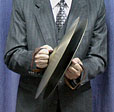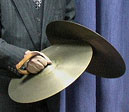|
A PAIR THAT'S ALWAYS IN THE LIMELIGHT: |
by Antonio Buonomo

|
It has happened to everyone, at least once, to pause and admire the evolutions of the cymbal player when a musical band goes by. This instrumentalist, who sometimes even steals the scene from the majorette, in addition to sustaining the marching rhythm along with the bass drum, almost has the obligation to perform choreographic movements and gestures that delight both young and old alike.
Even in the orchestra, the cymbal player is a personage of the highest importance; so much so that in competitions, in order to have a member who plays the cymbals well, many times, they pass over other instruments believed to be (even if wrongly) more noble. This is because a single stroke of the cymbals, properly performed in a timely manner, can accentuate the emotional intensity of a scenic and/or musical context. As proof of what I am saying, two highly dramatic situations come to mind that are worth mentioning: the first, immortalized in the famous Hitchcock film, “The Man Who Knew Too Much,” in which the killer uses a cymbal strike to cover the shot; and the second, that earned a thumbs up for one of our colleagues from a famous orchestra conductor. In this latter case (the epilogue of Puccini's opera Boheme), we had suggested substituting a suspended cymbal for the double symbols that are followed by the inconsolable Rodolfo's last desperate cry of pain at Mimi's death. The inclusion of cymbals in the orchestra dates from the middle of the Seventeenth century, by the credit for their diffusion, and regular use, goes to Gluck who used them in his opera, “Ifigenia in Tauride.” So, just like the castanets (macho and hembra), the cymbals, for this reason called a couple, are distinguished as male and female. The male is recognized by his slightly sharper and more silvery sound and is generally gripped with the right hand. As you know, the cymbals are played by striking them together in a slightly oblique position (fig. 1). If you have to buy a pair of cymbals, don't be satisfied just by testing them in the store or at the fair, but ask if you can try them out in a band or orchestra. In fact, it can happen that a pair of cymbals that play marvelously by themselves, are not able to blend perfectly with the strings, woodwinds and brass when brought into the orchestra. Like certain triangles that, there harmonics being poor, give definite sounds that soil the harmonies of the other instruments. With a pair of new instruments, the initial phase is the most delicate to deal with. It is no accident that they say that before cymbals do their best they have to “do their faces.” This statement means that, by playing, the metal reshapes itself; that is, it takes on the most suitable shape for the impact. In this way, the risk of suffocating the vibrations with a too-violent compression is reduced and the sound is also improved. The sound of the cymbals, beyond their quality and the ability of the player, also depends on their weight. To have enough thickness to provide a consistent and durable sound would require, for example, having a weight not less than 1.700 kg for each cymbal (assuming a diameter from 41 to 45 cm). There are so many effects that can be obtained from the cymbals that, obviously, we can't exhaust all of them here. Among their, most known and used, principal effects we can number: the so-called oscillating cymbals, or cymbals struck and raised upwards; dry strokes stifled against the chest; the roll and the various types of dragging. It should be said that the practice of raising the cymbals upwards after striking not only has a choreographic function but also serves to lengthen the vibration and helps it “travel” better. For cymbals, as for all other instruments, a good start is the foundation for all future improvement. If you start with a good grip you avoid physical problems, such as unaesthetic and annoying calluses on the hands, and the sound won't easily be confused with the sneezing of someone in the audience with a cold. It is advisable to avoid putting disks of insulating or cushioning material on the bells of the cymbals, that could block part of the vibrations. In order not to harm yourself (and to obtain the maximum vibration) it is better to learn to grip and play with the right technique. The most difficult to realize effects, after having learned the basic technique, are: the roll and the drag. The roll is achieved by rubbing the cymbals against each other in a rotating direction. To achieve a continuous and homogeneous sound, it is necessary to grip the cymbals, holding the fingers away from the bell. In this way, you provide sufficient play for oscillation and vibration when going fast. Certainly, this interesting effect, that was so dear to Wagner, is best performed with light cymbals. Unfortunately, light models don't always work well for the isolated and “ripped” strokes as well. So, its better to use a paid of medium dimensions and weight to play everything with the best results. There are two methods that are most often used for performing a drag. In the best known, you start with the plates close (so the upper edge of the right plate is touching the lower edge of the left one) and you drag the plates against each other, executing a rising motion with the right hand and a descending motion with the left. If the drag is long, it is a good idea to also execute a half-rotation, moving the rising plate to right and the one moving in the opposite direction to the left. In this way, at the end, you will find yourself in the opposite position from where you started (fig. 2). This system has the same function as the "figure eight" that is formed on the tambourine, when you perform a roll with the thumb, so as not to interrupt the sound. The other drag is obtained by resting the edge of one cymbal, held almost horizontal, in the central area of the other cymbal, held in an almost vertical position. This type of drag, being limited at least to the middle of the plate, has a shorter duration than the other, but, in compensation, is more incisive and easier to execute (fig. 3). Finally, to achieve dry strokes, you need to bring the cymbals quickly to your chest after striking. In this case, the vibrations are muffled better… in the “winter season,” i.e., when you can wear heavier clothing (fig. 4). From left to right, figures 1, 2, 3 and 4 |



Fig. 1
Fig. 2
Fig. 3
Article published by the magazine, “Percussioni.”